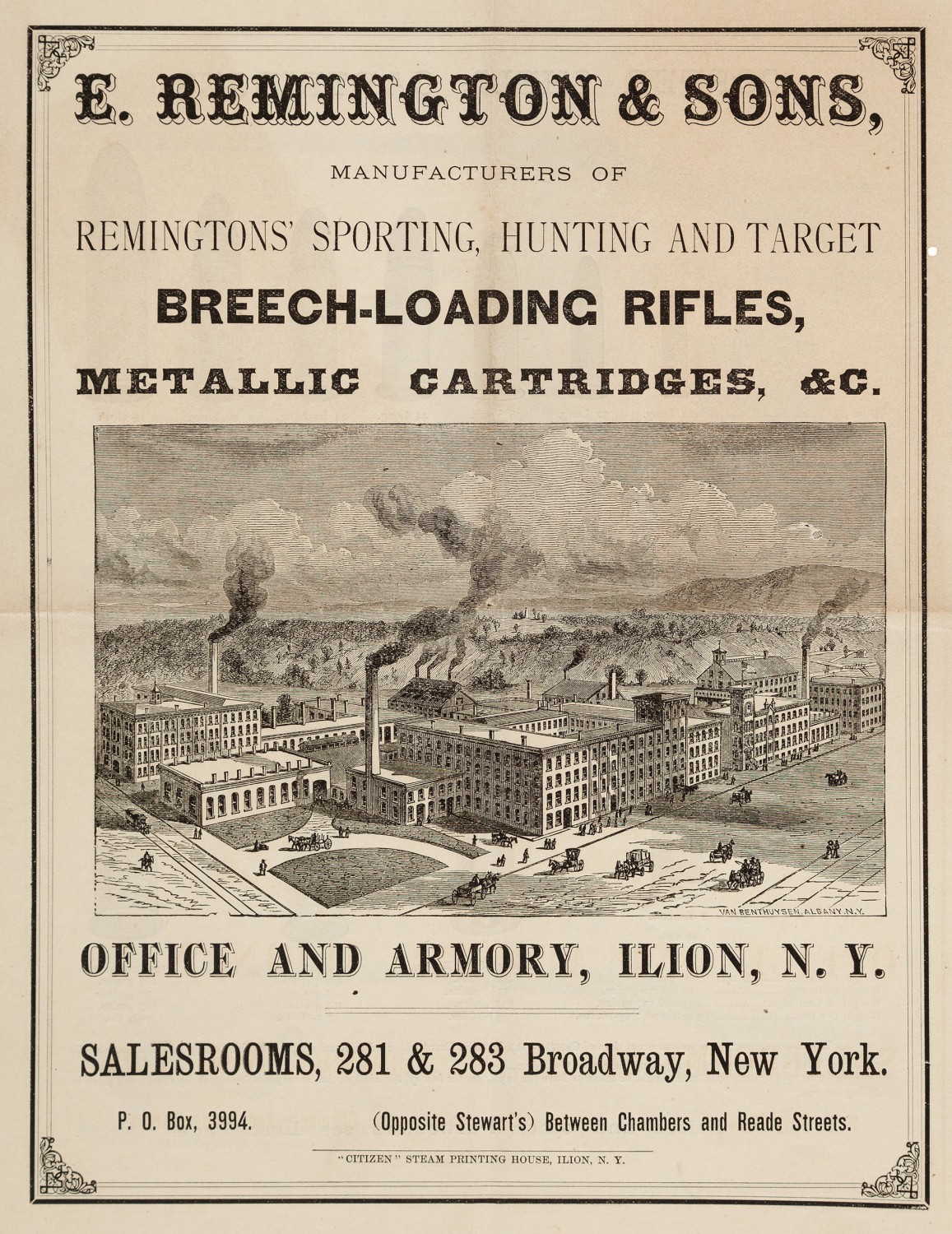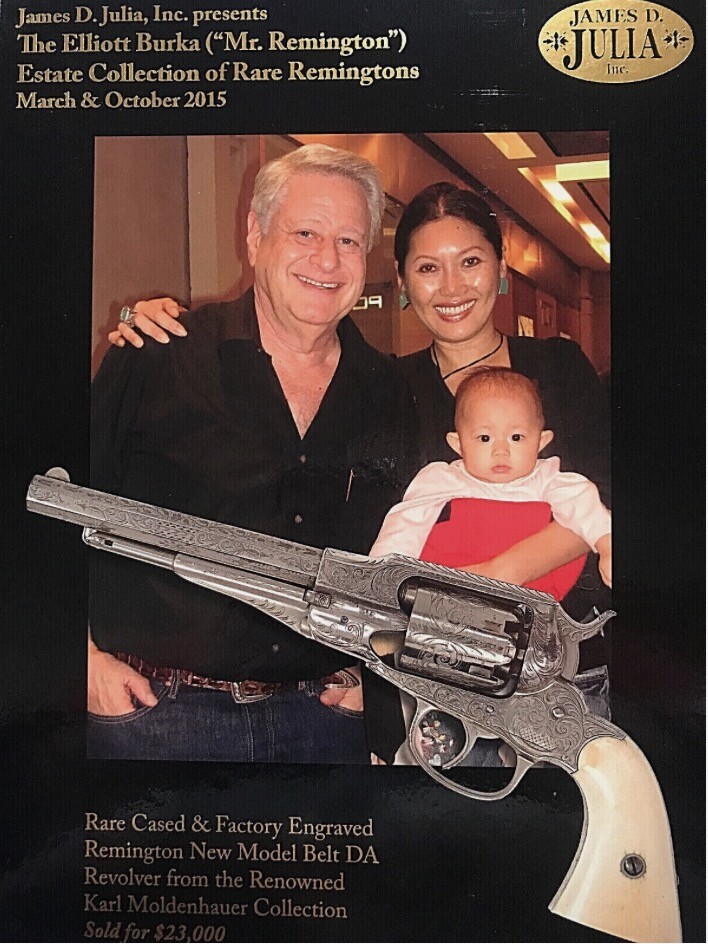by Laura Henkel PhD
ArtCulture PR had the distinct pleasure of facilitating a momentous occasion for The Golden Steer, marking its first expansion in 50 years. I took joy in sourcing artwork, memorabilia, and collectibles to adorn this iconic Las Vegas establishment. Not only did I curate treasures for the venue, but I also meticulously designed frames for each piece, ensuring a seamless integration of the venue’s exquisite art collection. This endeavor exemplifies ArtCulture PR’s commitment to delivering unparalleled creativity and sophistication to our clients, fostering unforgettable experiences for their patrons.
Delighted to unveil the historical significance of this exquisite specimen, I trust that you, the reader, will relish delving into the rich tapestry of arms manufacturing history in the United States.
E. Remington & Sons was founded by Eliphalet Remington in 1816 in Ilion, New York. Originally, he owned an iron forge in Litchfield, Connecticut whereby he fabricated and repaired tools, equipment, and hardware. His son, Eliphalet II, worked alongside him as a blacksmith learning the trade. In 1816, Eliphalet forged an improved rifle barrel that met the growing demand for flintlock rifles in the Mohawk Valley. With the completion of the Erie Canal in 1825, connecting Buffalo with Albany, commerce in the Mohawk Valley expanded remarkably, as did the demand for rifle barrels. To meet the increasing demand for more rifles, the Remingtons moved their forge and foundry from its rural setting to Morgan’s Landing (later Ilion), New York in 1928. The move coincided with the elder Eliphalet’s death, and Eliphalet II assumed control of the business. His eldest son, Philo, entered the business in 1839 to form “E. Remington & Son.” His other sons, Samuel and Eliphalet III, subsequently joined the organization in 1845 and the company’s name changed to “E. Remington & Sons”.
The Remingtons focused nearly exclusively on the production of rifle barrels during this period. The quality and affordability of these barrels were acknowledged due to the distinctive “REMINGTON” marking affixed to their breeches. A considerable number of independent gunsmiths in the Mohawk Valley, if not the majority, procured finished barrels from Remington, excluding those that were already rifled, and proceeded to craft firearms according to the specifications provided by their clients. In response to increased demand, Remington diversified their product line to include brass gun furniture, such as trigger guards, butt plates, and patch cases, and percussion locks.
In 1848, the company purchased gun-making machinery from the Ames Manufacturing Company of Chicopee, Massachusetts and took over a contract for Jenks breech loading percussion carbines for the U.S. Navy. Remington supplied the U.S. Navy with its first breech-loading rifle. Remington supplied the U.S. Army with rifles in the Mexican American War (1846 to 1848). Shortly after, Remington took over a defaulted contract (by John Griffith of Cincinnati) for 5,000 U.S. Model 1841 Percussion Mississippi rifles. Based on the success of filling these orders, subsequent contracts followed in the 1850s.

In 1858, Remington’s master mechanic, John F. Thomas, was granted a patent for a percussion cane gun and E. Remington & Sons was given half of the patent in 1859. The company’s “New Patent Gun Cane” began manufacturing in 1859 and about 500 of the percussion cane guns were made. The cane gun was a brilliant design as the cane concealed the mechanism. The cane’s cannon would shoot a .31 caliber ball using percussion caps that ignited black powder. Within the cane’s shaft was a short iron barrel with rifled edges, and from there the lead ball passed through a smooth brass tube. A piece of cork could be used as a walking muzzle plug to avoid a disastrous barrel blockage. After unscrewing the head/action from the barrel, a cartridge could be inserted to load the gun. To remove used cartridges, which did not have an ejector or extractor, one had to unscrew the action and poke the empty case with a rod.
In 1861, the company began to focus its energies on materials for the American Civil War and the percussion cane gun was suspended. In the same year, the company also saw a shift of leadership with Philo taking over following Eliphalet II’s death. Once the war ended in 1865, the cane gun was rechristened “Thomas Patent Cane Gun” in honor of its creator. In 1866, the process of adapting Remington’s cane guns to fire rimfire cartridges of .22 and .32 calibers occurred and it was with these long guns that Remington first used metallic cartridges. A reworked chamber at the barrel’s end and a barrel that screwed into, instead of onto, the action and the hammer, originally retained from the percussion variant, was subsequently superseded by a long rod that doubled as an extension for the firing pin were the two other changes to the ”Thomas Patent Cane Gun”. Remington advertised “The Remington Rifle Cane” as “Just the Thing for Taxidermists” and as “Protection against Dogs and Highwaymen.”

In 1873, an Edward K. Tyron Jr. & Co. catalog listed Remington’s cane gun for $8.00. In an 1877 advertisement, the gutta percha heads version cost $10.00 and the ivory heads were priced at $15.00 to the price. Caliber, case length (short or long), and projectile type (bullet versus shot) determined the price range of a box of one thousand cartridges to be between $6.00 and $12.00.

After Samuel passed away in 1882, Philo bought his stake in the business. E. Remington & Sons went into receivership in 1886 after suffering significant setbacks. In 1888, ownership of E. Remington & Sons left possession of the Remington family and was sold to new owners Hartley and Graham of New York, New York, and the Winchester Repeating Arms Company of New Haven, Connecticut, at which time the name was formally changed to the Remington Arms Company. The Remington Arms Company and Union Metallic Cartridge Company combined to form Remington-UMC, a single business, in 1910. Both the name and the ownership of the business changed in 1934 when DuPont acquired Remington-U.M.C. and reformed it as the Remington Arms Co., Inc. The armaments manufacturer from Ilion stayed a part of the DuPont company until 1993, when Clayton Dubilier Rice’s investment group bought Remington.
Remington Cane Guns are highly sought after by collectors of antique weapons, knickknacks, and curiosities from the 19th century. While other companies did make similar products, Remington’s offering is undeniably the pinnacle of this category’s development. The Remington Cane Gun is an impressive handgun that stands out from the crowd, surpassing pneumatic, percussion, and other metallic cartridge versions in terms of design and functionality. Impressive in their day, the single-shot cane gun allowed stylish gentlemen to carry both a weapon for self-defense and a must-have fashion piece of the nineteenth century. Since then, the cane gun has made special appearances in pop culture. Ian Fleming wrote about a cane gun in his novel, Casino Royale, and the gun appears in the television adaptation of the novel in 1954. The cane gun has also made special appearances before audiences in The Hound of the Baskervilles (1983), The A-Team (1985), Do or Die (1991), Day of the Warrior (1996), The World Is Not Enough (1999), and Sherlock: Case of Evil(2002).

According to Elliott Burka, a revered and consummate collector of rare Remington cane guns, published in the article, “Remington Rifle Cane”, American Society of Arms Collectors Bulletin 85 (April 2002), pages 1-10, he states the following:
“…my estimate of the number of each Remington rifle cane Emodel manufactured.
.31 percussion and conversion— Approx. 500
.32 rimfire— Approx. 2,000
.22 rimfire— Approx. 2,000
If my assumptions are anywhere near correct, the increased number of Remington rifle canes that were manufactured (a total of 4,500 over a 30-year period) still does not detract from the rarity and value of these guns. Many have been destroyed or ruined by natural disasters and carelessness of their owners.”
Cane guns are indeed becoming harder to acquire due to the frequency of their destruction, loss, or disposal by individuals bewildered by their nature and worth. Fortunately, such specimens are preserved by museums and private collectors who recognize their value. In December 2008, a Remington dog cane gun sold at Barneby’s for $10,350. In January 2015, a dog cane gun sold at James D. Julia Auctioneers for $11,500.

This Remington .32 caliber rimfire cane gun has the “dog’s head” handle, is fashioned out of a darker brown or black toned gutta percha, likely due to sun fading. Though the “dog’s head” handle is not necessarily the most rare handle variation seen on these canes, it is often cited as the most desirable. The shaft is sleeved in brown gutta percha. There is a small German silver band where the handle meets the shaft and an iron ferrule at the tip/muzzle which appears to be unmarked. It measures 31 1/4 inches overall. The gutta percha is showing mostly an attractive chocolate tone overall with some mild fading. The firearm is mechanically sound and in very good condition. The .32 caliber rimfire (live) ammunition has not been made in over 150-years. One live bullet was secured from Mike Tristano & Co. for presentation. Photo credit for the disassembled gun goes to Jim Supica of Supica Consulting LLC, and credit for the .32 short rim fire cartridges, produced by The Union Metallic Cartridge Co., goes to Wards Auctions Inc., adding to the visual appeal of the framing. All other images within the frame are sourced from the public domain.
Intrigued by our ability to enhance ambiance and elevate brand presence through art and design? Let ArtCulture PR bring your vision to life. Whether you’re a restaurateur, hotelier, or business owner seeking to transform your space, our expertise in curating unique collections and crafting bespoke design solutions will captivate your audience and leave a lasting impression. Contact us today to embark on a journey of artistic excellence and distinction.
